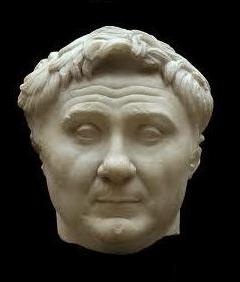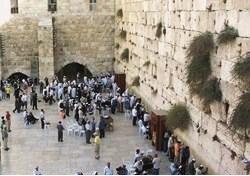THE ROMAN ERA 63 BC � 150 AD
The Hasmonean dynasty lasted almost exactly one century, and its end came about in circumstances similar to that that had brought it into being. Two Hasmonean brother � Aristobulus and Hyrcanus � had been fighting for control of the dynasty. Both decided to appeal to Rome�s favour to their cause. Hyrcanus, however, had a powerful chief-minister, Antipater, an Idumean (descendants of the Edomites) who had been forcibly converted to Judaism. Antipater was a very clever man, who long ago saw how the winds of change was blowing, and had quietly been trimming his own sails to catch them in  his favour. When the two brothers turned to Rome for a resolution Antipater managed the Roman general Pompey into his favour instead, so that when in 63 BC Pompey annexed Judea and turned it into a Roman client-state, it was Antipater�s son, the future Herod the Great, who was made ruler. In the time of Herod Jesus was born.
his favour. When the two brothers turned to Rome for a resolution Antipater managed the Roman general Pompey into his favour instead, so that when in 63 BC Pompey annexed Judea and turned it into a Roman client-state, it was Antipater�s son, the future Herod the Great, who was made ruler. In the time of Herod Jesus was born.
After Herod�s death in 4 BC, Judea � now a Roman province - fell to his son Archelaus �the Ethnarch,� a man who, according to Josephus the Jewish historian, had �all his father�s vices but none of Herod�s skills of competent statesmanship.� He was deposed in 6 AD. Except for four short years when it was ruled by Herod Agrippa I (41-44 AD) Judea came to be governed by �prefects� appointed by Rome, the most notable of these � at least from a Christian point of view � being Pontius Pilate.
The Jews did not find Roman rule a happy thing. Judea had become truly cosmopolitan, and a city like Caesarea (where Peter had been sent to witness to Cornelius and in which Philip lived with his �four unmarried daughters, who prophesied�) often became scenes of conflict between the Jews and the Gentiles. Things turned particularly ugly under Gessius Florus who had been appointed to his post by Nero in 64 AD. Florus was an insatiably greedy man for whom no bribe was too small to refuse and no gift too large to turn down. With money to be made, complaints by the Jews about such inter-ethnic/religious slights went unattended. In the end things came to a head and civilian unrest broke out that quickly escalated into full revolt in 66 AD. This, in turn, brought the full wrath of Emperor Vespasian (who was acclaimed emperor when Nero committed suicide in 68 AD) upon Judea. Jerusalem was ravished, and on 28 August 70 AD (or 9 Av, the same date, according to a later Jewish tradition, on which Nebuchadnezzar had destroyed the First Temple 650 years previously) the Temple  was razed, with nothing left of it except for a section of the retaining wall on the west (the so-called �The Wailing Wall� or �The Western Wall�). The Jewish rebels made a last desperate stand at Masada, a Herodian stronghold on the shores of the Dead Sea that they had commandeered. After several months of siege, the Romans breached the walls only to find that the rebels � 930 of them � had elected to commit suicide the night before, rather than face the shame of surrender. Only two women and five children survived to tell the tale.
was razed, with nothing left of it except for a section of the retaining wall on the west (the so-called �The Wailing Wall� or �The Western Wall�). The Jewish rebels made a last desperate stand at Masada, a Herodian stronghold on the shores of the Dead Sea that they had commandeered. After several months of siege, the Romans breached the walls only to find that the rebels � 930 of them � had elected to commit suicide the night before, rather than face the shame of surrender. Only two women and five children survived to tell the tale.
During a visit to Judea in 130 AD, Hadrian the Roman emperor decided to rebuilt the ruins of Jerusalem into a pagan Roman city named Aelia Capitolina.
Unhappiness with this development led to a �Second Jewish Revolt� between 132-135 under the Jewish leader Bar Kokhba. It was also put down. This time, however, the Romans would ban Jews from Jerusalem, and the province renamed Syria Palestina, a mean and hurtful recalling of the Philistines who inhabited the land before Israel conquered it. The scattered Jews � the Diaspora � would play no significant part in the life of Judea until the modern Zionist movement brought them back to the land in significant enough numbers and clout at the turn of the 19th-20th Cent.
Low Chai Hok
©Alberith, 2013
 his favour. When the two brothers turned to Rome for a resolution Antipater managed the Roman general Pompey into his favour instead, so that when in 63 BC Pompey annexed Judea and turned it into a Roman client-state, it was Antipater�s son, the future Herod the Great, who was made ruler. In the time of Herod Jesus was born.
his favour. When the two brothers turned to Rome for a resolution Antipater managed the Roman general Pompey into his favour instead, so that when in 63 BC Pompey annexed Judea and turned it into a Roman client-state, it was Antipater�s son, the future Herod the Great, who was made ruler. In the time of Herod Jesus was born.  was razed, with nothing left of it except for a section of the retaining wall on the west (the so-called �The Wailing Wall� or �The Western Wall�). The Jewish rebels made a last desperate stand at
was razed, with nothing left of it except for a section of the retaining wall on the west (the so-called �The Wailing Wall� or �The Western Wall�). The Jewish rebels made a last desperate stand at